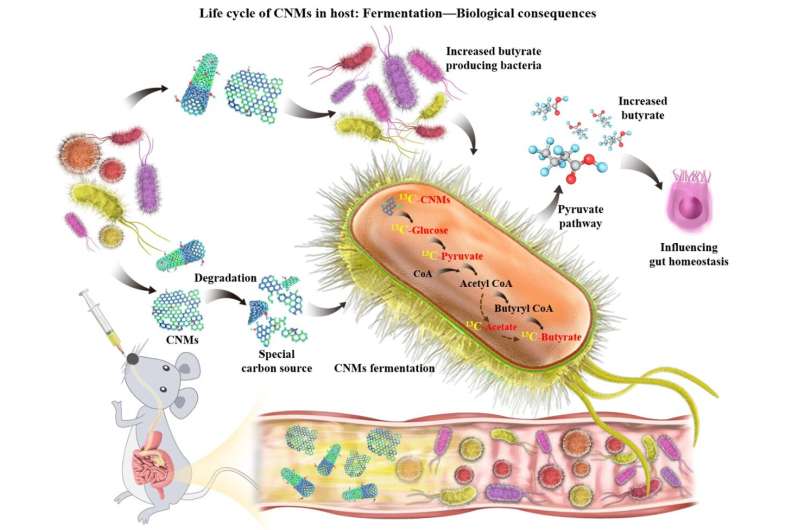This article has been reviewed according to Science X's editorial process and policies. Editors have highlighted the following attributes while ensuring the content's credibility:
fact-checked
peer-reviewed publication
trusted source
proofread
Study reveals gut microbiota can ferment carbon nanomaterials into organic metabolites

Recently, a research team led by Prof. Chen Chunying from the National Center for Nanoscience and Technology (NCNST) of the Chinese Academy of Sciences (CAS) revealed that gut microbiota can ferment exogenous carbon nanomaterials (CNMs) as carbon sources into short chain fatty acids. The study was published in Proceedings of the National Academy of Sciences and was reported as a Nature Highlight.
Gut microbiota are the major targets for exogenous nanomaterials through the oral route. Gut microbiota-governed biological processes determine the final fate of CNMs in the hosts. However, CNMs and numerous components in the gut, such as food, carbohydrates, proteins, and lipids, as well as the basic building blocks of life "cells," contain the same constituent element—carbon. It is very challenging to achieve precise analysis of the metabolic processes of CNMs in the gut using traditional methods.
To solve this issue, the research team revealed the "past and present" of carbon nanomaterials in gut microbiota through the application of stable isotope 13C labeling technology, isotope metabolic flow tracing technology, high-resolution mass spectrometry, and microbiota gene sequencing.
In this work, the researchers first found that gut microbiota could break down two types of CNMs: single-walled carbon nanotubes (SWCNTs) and graphene oxides (GO). By screening the intestinal metabolites, they demonstrated that short chain fatty acids significantly increased in the gut of mice treated with carbon nanomaterials by oral gavage.
Using stable isotope 13C labeled graphite oxide and metabolic flow tracing technology, they found that CNMs were like dietary fiber and could be used as an available carbon source by gut microbiota for degradation and fermentation, which entered the pyruvate metabolic pathway to generate butyrate. During this process, a variety of microbial enzymes, including hexokinase, pyruvate kinase, pyruvate dehydrogenase and butyrate kinase, were involved in the fermentation of CNMs into butyrate.
Microbial gene sequencing revealed that butyrate-producing bacteria are the dominant species that exploited CNMs to generate butyrate. Importantly, the excessive butyrate can affect gut homeostasis.
This study for the first time clarifies the entire metabolic process of CNMs from the source to the end, breaking the traditional belief that microbes can only use carbohydrates to synthesize organic butyric acid molecules. The research confirms that intestinal microorganisms can use artificially synthesized CNMs as carbon sources to generate endogenous organic metabolites, reveals the new biological fate of CNMs in the host, and provides important theoretical support for expanding the application scenarios of CNMs.
More information: Xuejing Cui et al, A new capacity of gut microbiota: Fermentation of engineered inorganic carbon nanomaterials into endogenous organic metabolites, Proceedings of the National Academy of Sciences (2023). DOI: 10.1073/pnas.2218739120
Gut microbes 'eat' nanoparticles—leading to microbiome changes, Nature (2023). DOI: 10.1038/d41586-023-01540-w
Journal information: Proceedings of the National Academy of Sciences , Nature
Provided by Chinese Academy of Sciences




















